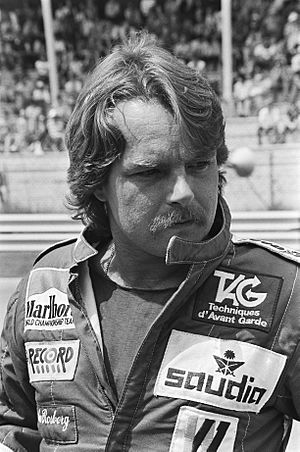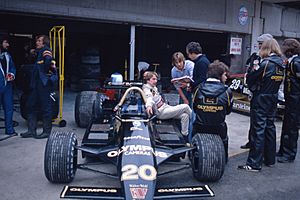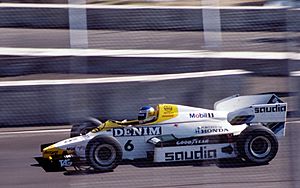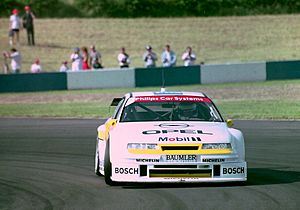Keke Rosberg facts for kids
Quick facts for kids
Keke Rosberg
|
|
|---|---|

Rosberg at the 1982 Dutch Grand Prix
|
|
| Born |
Keijo Erik Rosberg
6 December 1948 Solna, Stockholm, Sweden
|
| Spouse(s) |
Sina Gleitsmann-Dengel
(m. 1983) |
| Children | Nico Rosberg |
| Formula One World Championship career | |
| Nationality | |
| Active years | 1978–1986 |
| Teams | Theodore, ATS, Wolf, Fittipaldi, Williams, McLaren |
| Entries | 128 (114 starts) |
| Championships | 1 (1982) |
| Wins | 5 |
| Podiums | 17 |
| Career points | 159.5 |
| Pole positions | 5 |
| Fastest laps | 3 |
| First entry | 1978 South African Grand Prix |
| First win | 1982 Swiss Grand Prix |
| Last win | 1985 Australian Grand Prix |
| Last entry | 1986 Australian Grand Prix |
Keijo Erik "Keke" Rosberg (born 6 December 1948) is a famous Finnish former racing driver. He also worked as a manager in motorsport. Keke competed in Formula One, the highest class of racing, from 1978 to 1986.
He achieved his biggest success in 1982. That year, Keke Rosberg won the Formula One World Drivers' Championship with the Williams team. Throughout his nine seasons in Formula One, he won five Grand Prix races.
Keke was born in Sweden but grew up in Finland. He started his racing journey in karting. Later, he moved up to other racing series like Formula Vee. In 1975, he won the German Formula Super Vee Championship. At 29, Keke made his Formula One debut in 1978.
After his racing career, Keke became a manager for other drivers. He even managed his own son, Nico Rosberg, who also became a Formula One World Champion.
Contents
Keke's Early Life
Keke Rosberg was born on December 6, 1948. This happened in Solna, Sweden. His father was studying to be a veterinarian there.
Keke's parents, Lars and Lea, were from Hamina, Finland. In 1950, his family moved back to Finland. They first lived in a village where people spoke Swedish. Young Keke had some trouble with the language there. Later, his family moved to Hamina, Oulu, and Iisalmi.
Formula One Adventures
Starting with Smaller Teams: 1978–1981
Keke Rosberg started his Formula One career a bit later than some. He was 29 years old when he joined. Before F1, he raced in many other series. These included Formula Vee and Formula Two.
His first Formula One team was Theodore in 1978. In only his second race, he showed his talent. He won a special non-championship race in the rain. This race was called the BRDC International Trophy.
After that, Keke joined other teams like ATS and Wolf. These cars were not very competitive. He often struggled to finish races. In 1980, he joined Fittipaldi Automotive. He scored his first points and even got on the podium in his very first race with them. This happened at the Argentine Grand Prix. However, the Fittipaldi car was also not very fast.
Becoming a Champion with Williams: 1982–1985
Even with the struggles, the Williams team noticed Keke. Their champion driver, Alan Jones, retired. This opened a spot for Keke in 1982. With a better car, Keke had an amazing year.
He consistently earned points in races. He got his first victory at the Swiss Grand Prix that year. This race was held in France because Switzerland had banned motor racing.
The 1982 season was unusual. No driver won more than two races. Other top teams faced difficulties. Ferrari, for example, had tragic accidents with their drivers. Keke's Williams car used an older engine. It was not as powerful as the new turbocharged engines.
But Keke's consistency paid off. He won the Formula One World Drivers' Championship. He became the first World Champion from Finland. He won the title with only one victory. This tied a record for the fewest wins in a championship season.

In 1983, Williams struggled to adapt to the new turbo engines. Keke still won the Monaco Grand Prix. He also won a non-championship race called the Race of Champions.
In 1984, Williams started using powerful Honda turbo engines. Keke won the Dallas Grand Prix that year. He also got a second-place finish in Brazil.
The 1985 season was better for Keke and Williams. He had a new teammate, Nigel Mansell. The new Williams car was much improved. Keke won the Detroit Grand Prix. He also set a new record for the fastest lap in Formula One history at Silverstone. He drove at an average speed of over 259 kilometers per hour (160 mph). This record stood for many years.
Keke's fifth and final Grand Prix win was in 1985. It happened at the new Adelaide Street Circuit in Australia. This win showed he was great at street circuits. Four of his five wins were on these types of tracks.
Final Year with McLaren: 1986
After 1985, Keke decided to leave Williams. He joined McLaren, who were the champions of the previous two years. This seemed like a great move at the time.
However, the 1986 McLaren car was not as powerful as its rivals. Keke's teammate, Alain Prost, won the championship that year. Keke found it hard to adapt his driving style to the car.
A sad event also affected Keke deeply. His close friend, Elio de Angelis, died in a testing accident in May 1986. Keke decided to retire from Formula One at the end of the season. He later said he retired "too soon."
In his final race, the 1986 Australian Grand Prix, Keke was leading. But a tire problem forced him to stop. He later said he planned to let Alain Prost win anyway. This would help Prost win the championship.
Life After Formula One
After leaving Formula One, Keke Rosberg continued racing in other series. In the early 1990s, he raced for Peugeot in sports car races. He won two races with them.
Then, he moved to the German Touring Car Championship (DTM). He drove for Mercedes-Benz and Opel. In 1995, he started his own team, Team Rosberg. He stopped driving himself to focus on managing the team.
Team Rosberg has been very successful. They have won championships in various racing series. These include German Formula Three and the DTM.
Managing New Talent
Keke Rosberg spent many years managing other racing drivers. He helped his fellow Finnish drivers, JJ Lehto and Mika Häkkinen. Mika Häkkinen went on to become a two-time Formula One World Champion.
Until 2008, Keke also managed his son, Nico Rosberg. He guided Nico from his karting days all the way to Formula One. In 2013, Keke and Nico made history. They became the first father and son to both win the Monaco Grand Prix. Keke won it in 1983, and Nico won it 30 years later.
In 2016, Nico Rosberg won the Formula One World Championship. This made Keke and Nico the second father-son duo to both win F1 titles. The first were Graham Hill and Damon Hill.
Keke's Helmet Design
When Keke Rosberg was karting, his helmet was white with a blue stripe. For Formula One, a famous designer named Sid Mosca painted his helmet. It was white with a blue circle on top. There was also a large blue rectangle over the visor area.
In 1984, the rectangles changed to a yellow shape. Keke's son, Nico, used a helmet design that looked similar to his father's early in his F1 career. Nico's helmet used grey instead of blue and had flame designs. He changed his helmet design in 2014.
Images for kids
See also
 In Spanish: Keke Rosberg para niños
In Spanish: Keke Rosberg para niños






